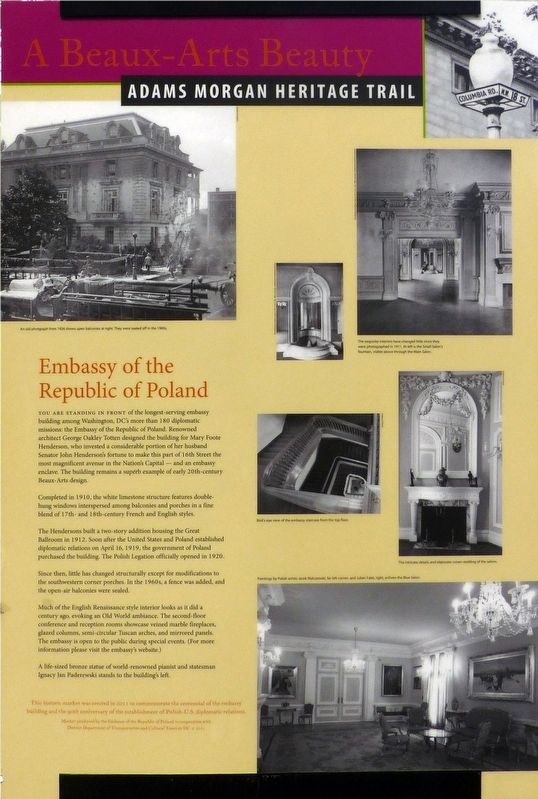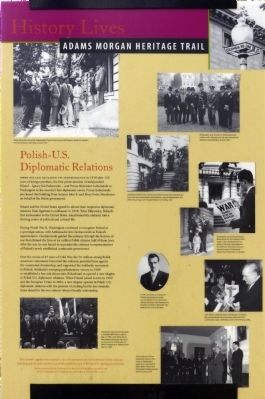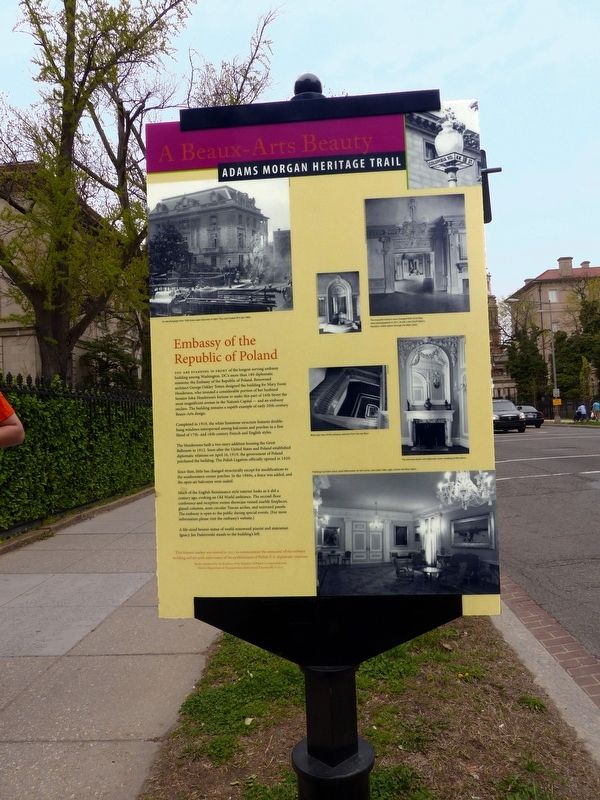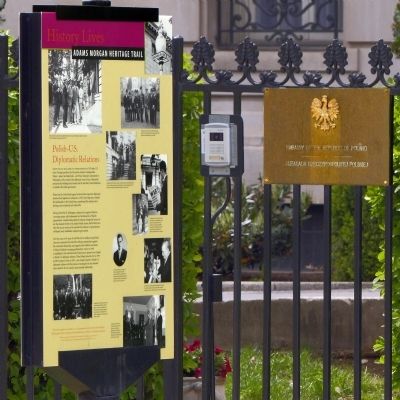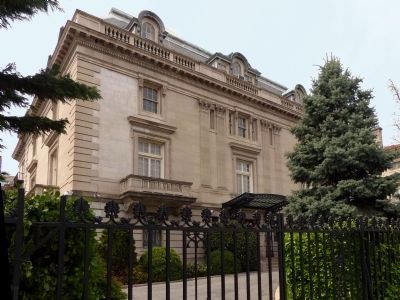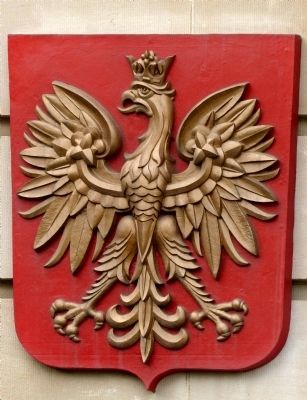Adams Morgan in Northwest Washington in Washington, District of Columbia — The American Northeast (Mid-Atlantic)
Embassy of the Republic of Poland / Polish-U.S. Diplomatic Relations
Adams Morgan Heritage Trail
Inscription.
Embassy of the Republic of Poland
A Beaux-Arts Beauty
You are now standing in front of the longest-serving embassy building among Washington DC's more than 180 diplomatic missions: the Embassy of the Republic of Poland. Renowned architect George Oakley Totten designed the building for Mary Foote Henderson, who invested a considerable portion of her husband Senator John Henderson's fortune to make this part of 16th Street the most magnificent avenue in the Nation's Capital — and an embassy enclave. The building remains a superb example of early 20th-century Beaux-Arts design.
Completed in 1910, the white limestone structure features double-hung windows interspersed among balconies and porches in a fine blend of 17th and 18-century French and English styles.
The Hendersons built a two-story addition housing the Great Ballroom in 1912. Soon after the United States and Poland established diplomatic relations on April 16, 1919, the government of Poland purchased the building. The Polish Legation officially opened in 1920.
Since then, little has changed structurally except for modifications to the southwestern corner porches. In the 1960s a fence was added, and the open-air balconies were sealed.
Much of the English Renaissance style interior looks as it did a century ago, evoking an Old World ambiance. The second-floor conference and reception rooms showcase veined marble fireplaces, glazed columns, semi-circular Tuscan arches, and mirrored panels. The embassy is open to the public during special events. (For more information please visit the embassy's website.)
A life-sized bronze statue of world-renowned pianist and statesman Ignacy Jan Paderewski stands to the building's left.
This historic marker was erected in 2011 to commemorate the centennial of the embassy building and the 90th anniversary of the establishment of Polish-U.S. diplomatic relations.
Polish-U.S. Diplomatic Relations
History Lives
When Poland declared its independence in 1918 after 123 years or foreign partition, the first prime minister of independent Poland — Ignacy Jan Paderewski — sent Prince Kazimierz Lubomirski to Washington as the country's first diplomatic envoy. Prince Lubomirski purchased this building from Senator John B. and Mary Foote Henderson on behalf of the Polish government.
Poland and the United States agreed to elevate their respective diplomatic missions from legations to embassies in 1930. Tytus Filipowicz, Poland's first ambassador to the United States, transformed the embassy into a thriving center of political and cultural life.
During World
War II, Washington continued to recognize Poland as a sovereign nation, with Ambassador Jan Ciechanowski as Poland's representative. Ciechanowski guided the embassy through the horrors of war that claimed the live so six million Polish citizens, half of them Jews. After the war, he was forced to surrender the embassy to representatives of Poland's newly established communist government.
Over the course of 45 years of Cold War, the 10-million-strong Polish American community boycotted the embassy, protested here against the communist dictatorship, and supported the Solidarity movement in Poland. Solidarity's sweeping parliamentary victory in 1989 re-established a free and democratic Poland and re-opened a new chapter in Polish-U.S. diplomatic relations. When Poland joined NATO in 1999 and the European Union in 2004, a new chapter opened in Polish-U.S. diplomatic relations with the promise of exciting but far less dramatic times ahead for the two nations' always friendly relationship.
This historic marker was erected in 2011 to commemorate the centennial of the embassy building and the 90th anniversary of the establishment of Polish-U.S. diplomatic relations.
Erected 2011 by Embassy of Poland, District Department of Transportation, Cultural Tourism DC.
Topics and series. This historical marker is listed in these topic
lists: Churches & Religion • War, Cold • War, World II. In addition, it is included in the Adams Morgan Heritage Trail series list. A significant historical year for this entry is 1918.
Location. 38° 55.48′ N, 77° 2.196′ W. Marker is in Northwest Washington in Washington, District of Columbia. It is in Adams Morgan. Marker is at the intersection of 16th Street Northwest and Fuller Street Northwest, on the right when traveling south on 16th Street Northwest. Touch for map. Marker is at or near this postal address: 2640 16th Street Northwest, Washington DC 20009, United States of America. Touch for directions.
Other nearby markers. At least 8 other markers are within walking distance of this marker. Ernest Malinowski (here, next to this marker); Jacek Karpiński (here, next to this marker); Maria Czaplicka (here, next to this marker); Jan Czochralski (here, next to this marker); Rudolf Weigl (here, next to this marker); Ignacy Łukasiewicz (here, next to this marker); Zofia Kielan-Jaworowska (here, next to this marker); Henryk Arctowski (here, next to this marker). Touch for a list and map of all markers in Northwest Washington.
Additional keywords. Holocaust, genocide, embassies,
diplomatic relations, Communism
Credits. This page was last revised on January 30, 2023. It was originally submitted on April 23, 2015, by Allen C. Browne of Silver Spring, Maryland. This page has been viewed 627 times since then and 62 times this year. Photos: 1. submitted on April 21, 2015, by Allen C. Browne of Silver Spring, Maryland. 2. submitted on April 23, 2015, by Allen C. Browne of Silver Spring, Maryland. 3. submitted on April 21, 2015, by Allen C. Browne of Silver Spring, Maryland. 4, 5, 6. submitted on April 23, 2015, by Allen C. Browne of Silver Spring, Maryland. • Bill Pfingsten was the editor who published this page.
